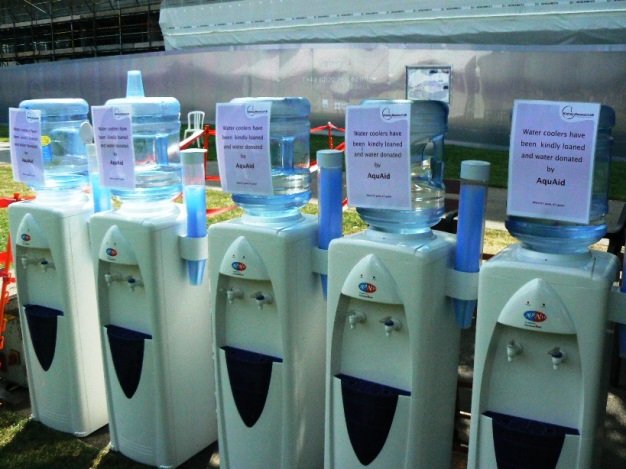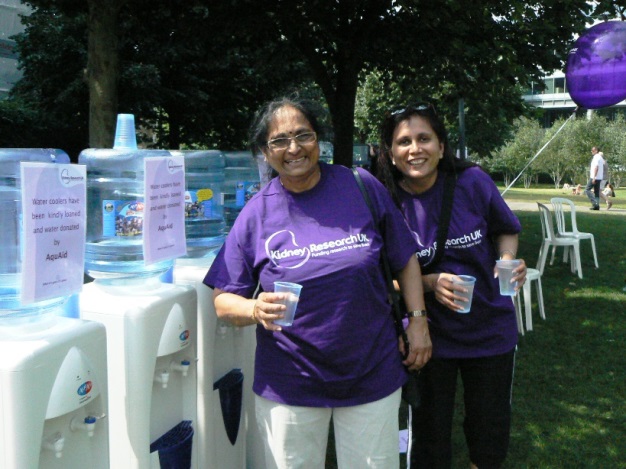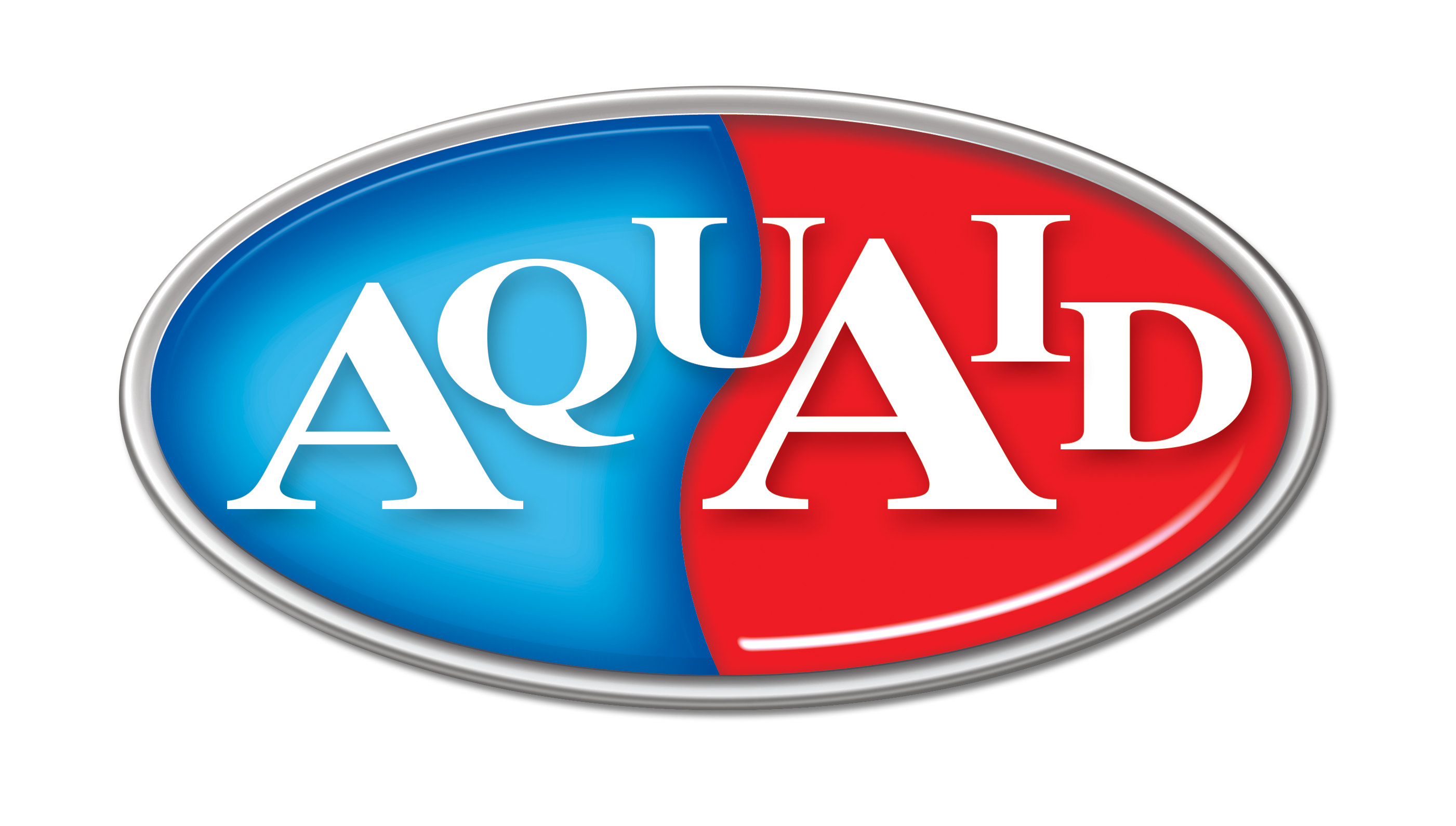
by Fern Shaw | Jul 26, 2013 | Charity, Health and Hydration
AquAid is all about water, hydration and water coolers, and most importantly, supporting sustainable charities.
Kidney Research UK is all about funding research aimed at finding better treatments, and ultimately a cure, for kidney disease. They have over £10.1 million invested in research at any one time, awarding grants to doctors, nurses and researchers across the UK. They also campaign for better patient access to renal services and are dedicated to raising awareness of kidney disease.
 As AquAid is constantly looking at ways to increase awareness about how important keeping our vital organs hydrated is, we chose to supply this year’s Kidney Research U.K. London Bridges Walk with a rather fabulous bank of bottle fed water coolers – to keep the energetic walkers well hydrated! This amazing walk covers a route of approximately 7 miles, and takes you over some of London’s most famous bridges.
As AquAid is constantly looking at ways to increase awareness about how important keeping our vital organs hydrated is, we chose to supply this year’s Kidney Research U.K. London Bridges Walk with a rather fabulous bank of bottle fed water coolers – to keep the energetic walkers well hydrated! This amazing walk covers a route of approximately 7 miles, and takes you over some of London’s most famous bridges.
There were 1 190 people who took part in this year’s event on 14th July 2013 and understandably, with the glorious sunny weather, there was many a thirsty walker whose eyes lit up when they saw the cool drinking water.
The event was a great success and they were joined by celebrities Nina Wadia and Nadia Sawalha, both well known for having starred in the popular soap EastEnders, along with DJ Oliver Scott from Star Radio, Cambridgeshire and fitness instructor Julia McCabe.
Have water, will walk!
by Fern Shaw | Jul 24, 2013 | Health and Hydration, water cooler, Water Coolers
Too Much Salt (High Sodium Levels)
The most common form of sodium imbalance is a blood sodium level that is too high. Excessive blood sodium levels mean that your body lacks enough water to cope with the amount of sodium it contains.
Contrary to popular belief, the primary cause of high blood sodium levels is not consumption of too much salt, but dehydration (not enough water intake).
Lack of adequate water intake is a very common condition in the United Kingdom due to the fact that most people fail to drink enough water each day, while also eating foods that are high in sodium. Other possible causes of dehydration include diarrhoea; vomiting; fever; excessive sweating (particularly during hot weather); abnormal kidney function; diabetes; head trauma or surgery involving the pituitary gland; imbalanced calcium and/or potassium levels; sickle cell disease, and use of drugs such as corticosteroids or diuretics.
When the amount of sodium in your body becomes too high, your body’s blood volume increases. When this happens extra fluid accumulates in the space surrounding your body’s cells. Such an accumulation of fluid around your cells can cause a variety of problems.
The most common symptoms of high blood sodium levels are confusion, depression, fatigue, fluid retention, irritability, lack of coordination, muscle cramps or twitching, nausea, restlessness, and general weakness.
Another common symptom of high sodium levels is oedema, which is characterized by swelling of body tissues, especially in the feet and ankles.
More serious symptoms of high sodium levels can include changes in blood pressure and heart rate, coma, seizure, and death.
A check-up by your physician is necessary to determine if you suffer from high blood sodium levels. If you are found to have this problem, then by all means you should avoid eating salty foods. But you should also beware of drinking salty beverages, such as sports drinks. And you should also increase your daily intake of water, especially following exercise or if you are taking medications.
It really is up to you to ensure that you take as best care that you can of the rather marvellous body that you’ve been given. If you’re already doing so, bully for you – perhaps you can share your knowledge with others less in the know.
So be especially careful in this heat, remember to keep hydrated and spread the water word as you’ve gathered around the water cooler.
by Fern Shaw | Jul 24, 2013 | water cooler
So, last week, we spoke about the keeping hydrated in a heat wave. This week, before everyone goes doo-lally with water usage, the Sergeant Major in me (he’s as stocky as Stockton and he’s moustache is more bristly than Bristol) harrumphed up and hissed ‘Water conservation at all costs Shaw, regardless!’ to me.
So, this blog, I’m moving away from the how to look after ourselves aspect and looking at how to look after our gardens, lawns and plants in this heat:
- Adjust your lawn mower to a higher setting. A taller lawn shades roots and holds soil moisture better than if it is closely clipped.
- Use sprinklers for large areas of grass. Water small patches by hand to avoid waste.
- Do not water your lawns and or plants during the hottest hours of the day – more than likely it will just burn the lawn and or plants and not feed either.
- Remember to check your sprinkler system valves periodically for leaks and keep the sprinkler heads in good shape.
- Don’t water your lawn on windy days when most of the water blows away or evaporates.
- Trickling or cascading fountains lose less water to evaporation than those spraying water into the air. In fact, during a heat wave, it’s advisable to turn the fountain off (unless it’s a drinking fountain or is a source of water for animals and pets).
And remember, preferable not to use the water from your office water cooler to water your garden, lawn or plants – unless of course it’s your carefully cultivated, ten year old bonsai that you keep on the conference table (a. because it’s inside and b. because it’s in the shade, so you’re allowed).
by Fern Shaw | Jul 18, 2013 | Health and Hydration
It seems strange that water should be such a scarce resource when our planet is drenched in 326 million trillion gallons of the stuff. But it turns out that less than one-half of 1 percent of it is drinkable. Out of the rest, 98 percent is oceanic salt water and 1.5 percent remains locked up in icecaps and glaciers.
Between droughts, natural disasters and the large-scale redistribution of moisture threatened by climate change, the need for new sources of potable water grows with each passing day. Each year, the global population swells by another 85 million people, but worldwide demand for freshwater increases at twice the rate of population growth, doubling every 20 years or so. Throughout the world, our most vital resource is under stress from pollution, dam construction, wetland and riparian (meaning of, relating to, or situated on the banks of a river), ecosystem destruction, and depletion of groundwater aquifers, with poor and marginalised populations getting the worst of it.
So why can’t we convert seawater into drinking water? Actually, we can and we do. In fact, people have been making seawater drinkable at least as far back as the ancient Greeks. But when taken to the scale of cities, states and nations, purifying seawater has historically proven prohibitively expensive, especially when compared to tapping regional and local sources of freshwater. However, as advancing technology continues to drive costs down and freshwater continues to grow scarcer and more expensive, more cities are looking to seawater conversion as a way to meet this vital demand.
How and where is desalination used today?
Desalination has come a long way in the 2,400 years or so since people boiled salt water and collected the steam in sponges. Yet, the most widely used method is still based on the same principle: distillation. Essentially, distillation artificially mimics what occurs in nature: Heated water evaporates to become water vapour, leaving salts and impurities behind, and then condenses as it cools to fall as freshwater (aka rain). Distillation plants refine and speed up this process by applying artificial heating and cooling and by evaporating water under lower air and vapour pressure, which significantly reduces its boiling point. This method requires a great deal of energy, however, so distillation plants are often located alongside power plants, where waste heat is available to bring the water up to a volatile temperature.
Another method, reverse osmosis (RO) desalination, uses pressure to force water through filters, straining out other substances at the molecular level. Developed in the 1960s, the process became feasible on a commercial scale in the 1970s, ultimately replacing distillation as the method used in most new desalination facilities, in part because it requires less energy. Besides removing salt, both methods remove virtually every mineral and most biological or organic chemical compounds, producing water that is safe to drink.
As much as desalination has increased over the years, it is still just a drop in the bucket.
Of course, you lucky fish don’t need to resort to these rather extreme applications – all you need to do is visit us here , drop us an e-mail and no sponges, boilers (we have those too by the by) necessary; just a range of water coolers tailor-made to suit your requirements. We’ll be happy to guide you in the right choice of water cooler solutions using our oodles of experience.
So, really, step away from that manky sponge and make use of our expertise.
Excerpts from https://science.howstuffworks.com/environmental/earth/oceanography/desalination.htm
by Fern Shaw | Jul 5, 2013 | Health and Hydration
Cereal. I personally have never been a fan. Bo-ringggg. The name itself conjures up an image of sleepy-eyed morning zombies sitting at the kitchen counter cud chewing their way through their morning repast.
I’ve always been more of the ‘Breakfast? Pah! Breakfast is for sissies’ type of roller. Me, I chug-a-lug 2 mugs of industrial strength coffee, come ten o’clock, I’m invincible. We won’t mention that come two thirty-ish, you’d invariably find me in a little heap draped around the water cooler, sobbing piteously without enough energy to raise my Despicable Me water bottle to the spigot.
Anyhow, I digress. Consequently, as with most bad eating habits, there came a point when my poor digestive system rebelled. Quite painfully. So I realised I had to woman up and start eating breakfast. But not the full Monty type of breakfast; bacon, eggs, tomatoes, toast, etceteraa, but … cereal type of breakfast.
I remembered in the mists of time that I had once tried muesli. Not the sugar coated, candy type of muesli, but rolled oats, dry as the desert and enough seeds and nuts to keep an aviary of seed cracking birds happy for a week type of muesli.
Apparently, the muesli I was after is called Bircher’s Muesli:
Etymology (fancy term for the origin of a word and the historical development of its meaning.)
Originally known in Swiss German as Birchermüesli or simply Müesli, the word is an Alemannic diminutive of Mues which means “puree” or “mash-up.” See, enuff said – “mash-up” says it all!
History
Muesli was introduced around 1900 by the Swiss physician Maximilian Bircher-Benner for patients in his hospital, where a diet rich in fresh fruit and vegetables was an essential part of therapy. It was inspired by a similar “strange dish” that he and his wife had been served on a hike in the Swiss Alps. Bircher-Benner himself referred to the dish simply as “d’Spys” (Swiss German for “the dish”, in German “die Speise”). Muesli in its modern form became popular in Western countries starting in the 1960’s as part of increased interest in health food and vegetarian diets. Traditional muesli was eaten with lemon juice and not milk. Goodness gracious, lemon?
Packaged muesli is a loose mixture of mainly rolled oats together with various pieces of dried fruit, nuts, and seeds. It commonly contains other rolled cereal grains such as wheat or rye flakes as well. There are many varieties. This dry packaged muesli can be stored for many months. It can be served quickly after mixing it with milk, yogurt, coffee, hot chocolate, fruit juice, or water.
So, if you, like me, have been given a serious health slap by your very own body, take a page out of my book. Skip the caffeine charging coffees on an empty stomach; pack your moo-oo-sli into your ‘lunchbox’ every morning and meet your workmates around the water cooler, (so that you have company while you cud chew your way through your brekkie), pour water into your breakfast of champions and you’re set for the day.

 As AquAid is constantly looking at ways to increase awareness about how important keeping our vital organs hydrated is, we chose to supply this year’s Kidney Research U.K. London Bridges Walk with a rather fabulous bank of bottle fed water coolers – to keep the energetic walkers well hydrated! This amazing walk covers a route of approximately 7 miles, and takes you over some of London’s most famous bridges.
As AquAid is constantly looking at ways to increase awareness about how important keeping our vital organs hydrated is, we chose to supply this year’s Kidney Research U.K. London Bridges Walk with a rather fabulous bank of bottle fed water coolers – to keep the energetic walkers well hydrated! This amazing walk covers a route of approximately 7 miles, and takes you over some of London’s most famous bridges.